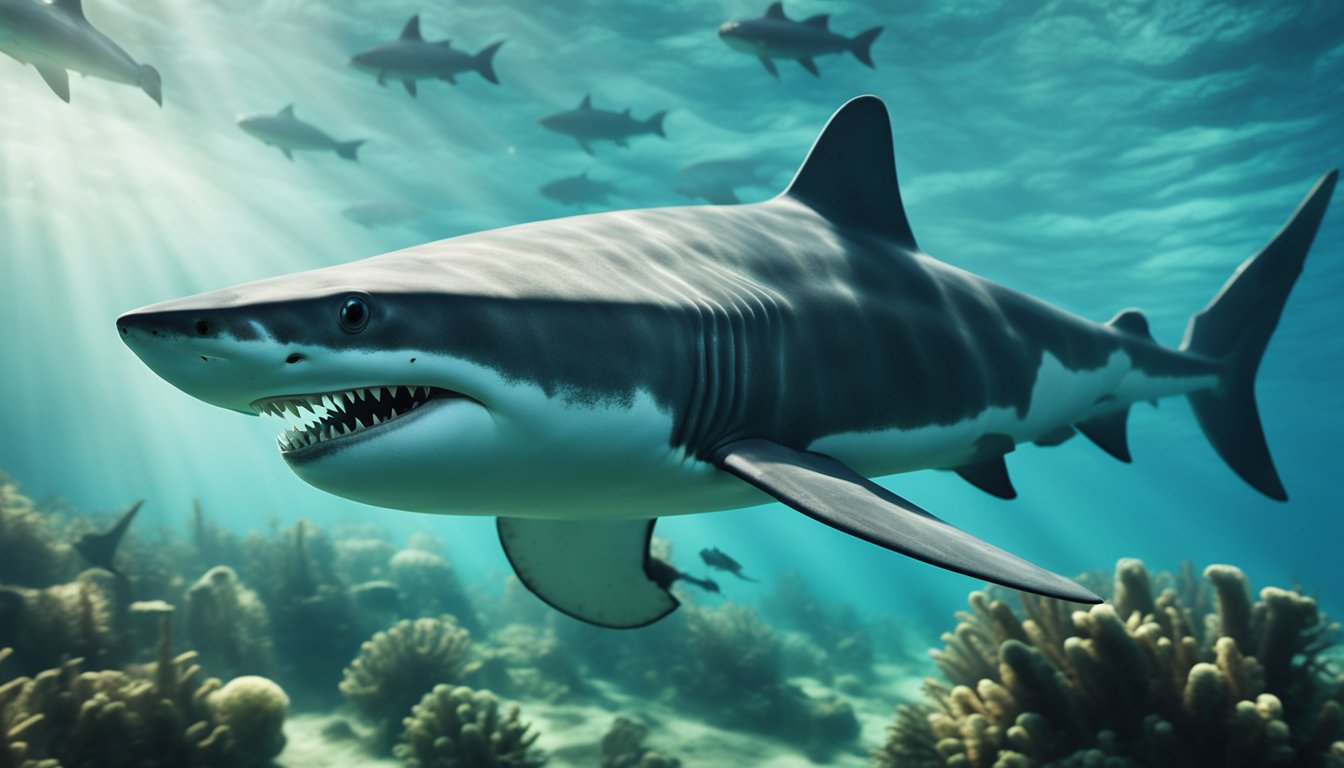Helicoprion is an extinct prehistoric shark that lived approximately 290 million years ago.
What makes this ancient creature unique is its bizarre, buzz-saw-like jaw.
Unlike modern-day sharks that have rows of teeth, Helicoprion had a single spiral-shaped tooth whorl that extended from its lower jaw.
This tooth whorl was made up of hundreds of individual teeth that would continuously grow and replace themselves throughout the shark’s lifetime.

Scientists have long been fascinated by Helicoprion’s unusual jaw structure, and for many years, they were unsure of how it functioned.
However, recent research has shed some light on this mystery.
It is now believed that Helicoprion used its saw-like jaw to slice through soft-bodied prey such as squid and other small fish.
The jaw would roll back and forth, allowing the shark to saw through its prey with ease.
This unique feeding mechanism is just one of the many reasons why Helicoprion continues to captivate people even today.
Mysterious Fossils Unearthed
Helicoprion, the prehistoric shark with a buzz-saw jaw, is one of the most fascinating creatures that ever existed.
Its fossils have puzzled paleontologists for many years, and the mystery surrounding this ancient fish continues to captivate scientists and the public alike.
Discovery and Analysis
The first Helicoprion fossils were discovered in the early 20th century in Idaho, USA, by a team of paleontologists led by Dr. Thomas D. Stewart.
The fossils were found in the Phosphoria Formation, a rock formation that dates back to the Permian period, about 290 million years ago.
The fossils consisted of spiral-shaped structures that were initially thought to be the animal’s teeth.
However, it was not until the 1950s that scientists realized that the spirals were, in fact, part of the animal’s lower jaw.
The jaw was shaped like a buzz-saw, with a series of teeth arranged in a spiral pattern.
Since then, paleontologists have been trying to reconstruct the animal’s appearance and behavior based on the fossils.
Thanks to modern technology, such as CT scans, scientists have been able to create 3D models of the jaw and piece together the puzzle of this enigmatic creature.
Helicoprion’s Place in History
Helicoprion lived during the late Carboniferous to the early Permian, a time when the earth was very different from what it is today.
The Paleozoic era was marked by the emergence of complex life forms, such as amphibians, reptiles, and insects.
Helicoprion was not the only strange creature to inhabit the oceans during this time.
The seas were also home to other bizarre animals, such as the trilobites, ammonites, and crinoids.
The Permian period was followed by the Triassic, a time when the first dinosaurs appeared.
Helicoprion disappeared from the fossil record during the early Triassic, about 250 million years ago, along with many other marine species.
Today, the Idaho Museum of Natural History is home to one of the largest collections of Helicoprion fossils in the world.
The museum’s curator, Leif Tapanila, has been studying these fossils for many years and has made many important discoveries about this ancient shark.
Fun Fact: Helicoprion’s buzz-saw jaw was not only used for hunting, but also for self-defense.
The jaw could rotate, allowing the animal to fend off predators from any angle.
Overall, Helicoprion’s fossils are a testament to the diversity and complexity of life on earth.
These mysterious fossils continue to inspire scientists and the public alike, and there is still much to be learned about this fascinating creature.
Anatomy of a Buzz-Saw Predator

The Helicoprion is an extinct shark species that lived over 290 million years ago during the late Carboniferous to the early Permian period.
This shark is known for its unique spiral-toothed jaw that resembles a buzz-saw, which is where it gets its name from.
The Helicoprion’s feeding apparatus is a fascinating topic that has captivated scientists and the public alike.
In this section, we will explore the dental structure and feeding mechanism of this ancient predator.
Unique Dental Structure
The Helicoprion’s jaw structure is one of the most unique in the animal kingdom.
The lower jaw of the Helicoprion is elongated and contains a series of tooth whorls that form a spiral shape.
These tooth whorls are serrated and resemble a circular saw blade.
The exact arrangement of these tooth whorls has been the subject of much debate among scientists, but recent research has suggested that they were located at the back of the jaw.
The Helicoprion’s Diet
The Helicoprion’s feeding mechanism was specialized for capturing and consuming soft-bodied prey such as cephalopods.
The saw-like tooth whorl was used to slice through the soft tissues of its prey, while the serrated teeth were used to hold onto the prey and prevent it from escaping.
The jaw of the Helicoprion created a rolling-back and slicing mechanism that allowed it to quickly and efficiently consume its prey.
Fun Fact: The Helicoprion’s mouth is measured at 10 inches across, which is about the size of a large pizza.
Imagine a shark with a pizza-sized buzz-saw jaw swimming towards you!
In conclusion, the Helicoprion’s unique dental structure and feeding mechanism make it one of the most fascinating predators in the animal kingdom.
Its spiral-toothed jaw and saw-like tooth whorls were specialized for capturing and consuming soft-bodied prey, making it a formidable predator in the prehistoric oceans.
Evolution and Extinction

Helicoprion is an extinct cartilaginous fish that lived in the prehistoric oceans during the late Carboniferous to the early Permian, about 290 million years ago.
It is known for its unique spiral-toothed jaw, which has fascinated scientists and the public alike.
From Helicoprion to Modern Relatives
Helicoprion belongs to the eugeneodontida, a group of extinct cartilaginous fishes that are related to modern-day sharks, rays, and chimaeras.
These shark-like fishes had a cartilaginous skeleton, a dorsal fin, and were marine predators.
Chimaeras, also known as ratfish or ghost sharks, are the closest living relatives of Helicoprion.
They belong to the subclass Holocephali, which is a group of cartilaginous fishes that have a unique type of jaw structure.
Unlike sharks and rays, chimaeras have a single pair of upper and lower jaws that are fused together.
Recent studies suggest that chimaeras diverged from sharks and rays about 420 million years ago.
This is based on DNA and molecular evidence of modern sharks and chimaeras, as there are no fossils of these animals from this period of time.
Helicoprion is believed to have gone extinct during the Permian-Triassic extinction event, which occurred about 252 million years ago.
This event was one of the most catastrophic events in the history of life on Earth, leading to the extinction of 96% of all marine species and 70% of all terrestrial vertebrate species.
Fun fact: The spiral-toothed jaw of Helicoprion was initially thought to be a horn or a tusk.
It was not until the discovery of complete specimens that scientists realized it was part of the jaw structure.
Frequently Asked Questions

What unusual feature did the Helicoprion possess?
The Helicoprion had a unique spiral-toothed jaw that resembled a buzz-saw.
This feature made the Helicoprion stand out from other prehistoric sharks and has fascinated scientists and the public alike for many years.
How did the unique jaw of the Helicoprion function?
The teeth of the Helicoprion were located in the back of its jaw and were arranged in a spiral pattern.
The jaw of the Helicoprion created a rolling-back and slicing mechanism that allowed it to capture and eat its prey.
What era did the Helicoprion live in, and when did it go extinct?
The Helicoprion lived during the late Carboniferous to the early Permian era, about 290 million years ago.
It went extinct around 250 million years ago during the Permian-Triassic extinction event.
Can you describe the size of the Helicoprion compared to modern sharks?
The Helicoprion was about the size of a modern-day Great White Shark, reaching lengths of up to 25 feet.
However, the Helicoprion had a much smaller brain case and a more primitive body structure compared to modern sharks.
What did the Helicoprion likely eat with its buzz-saw jaw?
The Helicoprion likely ate a variety of prey, including hard-shelled animals such as ammonoids, and soft-tissued prey such as squid.
Scientists have also found evidence of Helicoprion bite marks on the remains of other prehistoric marine animals.
What evidence do scientists have of the Helicoprion’s existence?
Scientists have discovered fossils of the Helicoprion’s unique spiral-toothed jaw, which has helped them to study and understand this prehistoric shark.
They have also found fossilized vertebrae and spines, as well as evidence of Helicoprion bite marks on other fossils.
Fun Fact: The Helicoprion’s spiral-toothed jaw was once thought to be a part of its dorsal fin, and it wasn’t until the late 20th century that scientists discovered it was actually a part of its jaw!






